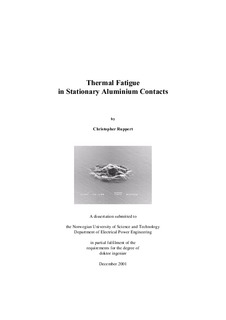| dc.contributor.author | Ruppert, Christopher | nb_NO |
| dc.date.accessioned | 2014-12-19T13:29:17Z | |
| dc.date.available | 2014-12-19T13:29:17Z | |
| dc.date.created | 2002-01-17 | nb_NO |
| dc.date.issued | 2002 | nb_NO |
| dc.identifier | 121758 | nb_NO |
| dc.identifier.isbn | 82-471-5383-1, h. | nb_NO |
| dc.identifier.uri | http://hdl.handle.net/11250/249671 | |
| dc.description.abstract | The conductive area of a stationary electrical contact consists of many small contact spots. The contact spots can be described as narrow metal bridges across the interface between two conductors. Deterioration of a contact is closely related to processes occurring in these microscopic areas. The objective of this work is to clarify the basic mechanisms affecting the reliability and degradation of an electrical contact by closely studying the contact spots.
Particular emphasis has been put on examining the contact spots occurring in aluminium-aluminium interfaces when passing AC. Due to the small thermal capacity of a contact spot the temperature in the contact spot cycles with twice the frequency of the applied AC. The minimum temperature attained during one cycle being the bulk temperature of the conductor, the maximum temperature can in heavily stressed contacts be close to the melting point of the conductor material. In the idealized contact used in the present investigation, this thermal cycling may initiate thermal fatigue processes in the contact spot region.
Microscopic cracks appear in the contact spot region as the result of thermal fatigue processes. The cracks not only lower the mechanical strength of the conductor in close vicinity of the contact spot, they also cause a higher electrical resistivity in these areas.
Alloying a tracer metal in one of the electrodes of the contact allows for closer investigation of the crack propagation as it occurred during the experiments. The tracer migrates into the heated contact spot region of the opposite electrode where the cracks constitute a barrier impairing further diffusion into the electrode. Further information on the thermal fatigue processes in the contact spot region is obtained when examining metallographic images of cross sectioned contact spots. Here it can be seen that the repetitive thermal stresses give rise to clearly localized recrystallisation in the contact spot region.
Thermal fatigue is a well known failure mechanism in mechanical structures. It has to the authors knowledge not previously been associated with the deterioration of contact spots. However, the mechanical damage in the contact spot region caused by the temperature cycling also has a detrimental effect on the electrical behaviour of the contact. It is therefore suggested that thermal fatigue is of considerable importance to the reliability and degradation of stationary electrical contacts. | nb_NO |
| dc.language | eng | nb_NO |
| dc.publisher | Fakultet for informasjonsteknologi, matematikk og elektroteknikk | nb_NO |
| dc.relation.ispartofseries | Doktoravhandlinger ved NTNU, 1503-8181; 2001:113 | nb_NO |
| dc.subject | Elektriske kontakter | no_NO |
| dc.subject | Aluminium | no_NO |
| dc.title | Thermal fatigue in stationary aluminium contacts | nb_NO |
| dc.type | Doctoral thesis | nb_NO |
| dc.source.pagenumber | 104 s. | nb_NO |
| dc.contributor.department | Norges teknisk-naturvitenskapelige universitet, Fakultet for informasjonsteknologi, matematikk og elektroteknikk | nb_NO |
| dc.description.degree | dr.ing. | nb_NO |
| dc.description.degree | dr.ing. | en_GB |
